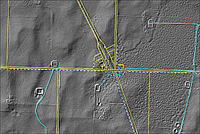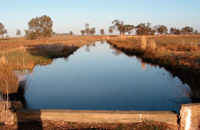ArcNews Online
Fall 2010
[an error occurred while processing this directive]Changing the Channel
Lidar and GIS Fast-Track Australia's Wimmera Mallee Pipeline Project
Highlights
- Enterprise GIS manages data-rich lidar and orthophotography, saving time, resources, and money.
- Massive surface datasets were stored in an ArcGIS database.
- Terrain data is quickly processed and analyzed using the ArcGIS Server 3D extension.

An example of the 2-meter hillshade elevation grid created using ArcGIS data processing tools. Visible features include redundant on-farm storage dams as well as the open-channel network.
The Wimmera Mallee Pipeline Project is one of the largest engineering initiatives currently under way in Australia. It spans an area of 11,700 square kilometers and aims to increase the efficiency of water distribution in the Wimmera and Mallee regions through pipelines and pump stations. From the outset, the project had a design and construction timeline of 10 years, with an estimated cost of $US688 million. But when data-rich lidar and orthophotography were introduced into the project, which is managed in an enterprise GIS, project engineers were able to fast-track the 8,800-kilometer (5,468-mile)-long pipeline project, saving time, resources, and money.
Pipe Dreams
As early as the 1890s, there had been talk of replacing the inefficient Wimmera Mallee open-channel system with a more effective pipeline network that would provide a sustainable water supply to the farms and residents of northwestern Victoria, Australia. But it was just talk—a pipe dream for the dryland farming and rural region reaching from the Grampian Mountains in the south to the Murray River, some 300 kilometers north.
Throughout the twentieth century, despite its inefficiencies in supporting the area's agriculture, the channel system was extended, branching out for a total of 17,500 kilometers (10,800 miles). Meanwhile, the earthen channel system continued to divert water away from already taxed sources such as the Wimmera and Murray rivers; reservoirs in the Grampians; and Victoria's largest freshwater lake, Lake Hindmarsh. Add six years of below-average rainfall at the turn of the century, regional reservoirs at less than 10 percent capacity, and a channel system that was highly dysfunctional, and the result was a dryland region that could no longer sustain agriculture.
Studies done around the same time showed that of the 120,000 megaliters of water released into the channel system in an average year, only 17,000 were actually used by customers. The rest, up to 80 percent, was lost from the open channels due to evaporation and leakage. A water loss analysis concluded that 85,000 megaliters of water per year were being lost from the channels, plus another 18,000 megaliters from farm dams through evaporation and seepage.
By the year 2000, it became evident that the 100-year-old pipe dream needed to become a reality, and it had to happen quickly. Without a new pipeline system, the Wimmera Mallee region's production of livestock, wheat, barley, canola, faba beans, field peas, and chickpeas would cease to exist, not to mention the towns and businesses in the area that required water to survive.
Members of the community and a steering committee lobbied for a pipeline, yet it was not until 2005 that the Commonwealth of Australia and the Victoria state government reached an agreement on the funding of the Wimmera Mallee Pipeline Project (WMPP). In the same year, it was announced that Grampians Wimmera Mallee Water (GWMWater) would be responsible for the delivery of the estimated 10-year project, but those with livelihoods at stake had to wonder if a completed pipeline in 10 years would be too little, too late.

Although it served northwestern Victoria for more than a century, the branching 17,500-kilometer-long Wimmera Mallee open-channel system was losing drastic amounts of water due to evaporation and leakage.
Let There Be Lidar
Before GWMWater could start designing more than 8,800 kilometers of pipeline and building 40 pump stations, it had to undertake a time-intensive environmental analysis and survey of more than 11,700 square kilometers (4,530 square miles) of land. GWMWater knew that capturing and analyzing the required amount of data over such a large and diverse area of terrain and vegetation would not be feasible by relying on photogrammetry and surveyors alone. Plus the massive amount of data resulting from such a survey also needed to come in a file format friendly to the GIS-based software platform that GWMWater had launched to manage the project.
The search for the right solution led GWMWater to AAMHatch, an Australia-based firm specializing in geospatial services and products. GWMWater knew it could fast-track the project from a 10-year to a 5-year schedule by utilizing light detection and ranging (lidar)-based imagery packaged in GIS spatial datasets of the entire project area, and AAMHatch possessed the lidar expertise to make it happen.
Covering New Ground
Utilizing Esri's terrain data type, which allows massive surface datasets to be stored in an ArcGIS geodatabase, AAMHatch created terrain datasets of the project area comprising 1.3 billion points. ArcGIS terrains provide optimized performance at multiple resolutions through the use of terrain pyramids that quickly retrieve only the data needed for the required level of detail in a given area of interest. Having all this data in a GIS would prove crucial in project workflows and data sharing, since the range of people accessing the WMPP GIS data varied from design engineers, planners, contractors, and government agencies to auditors, project managers, field inspectors, environmental and cultural heritage advisors, and land officers.
Armed with multiple lidar units with large-format digital cameras, air crews worked day and night to capture the data and check successful coverage while surveyors processed the GPS data and airborne laser scanner data and analysts worked on data processing. Within a week, AAMHatch provided digital terrain model datasets of approximately 15-meter vertical accuracy at one sigma on open areas, with an average laser strike spacing of 1.3 meters.
The data was delivered in phases, so GWMWater and its contractors would receive components of the data as they became available. The terrain data was complemented by orthoimagery with 60-centimeter image resolution. Stored in the WMPP GIS, the lidar and orthoimagery data provided a current view of the land use, land cover, and terrain—all data that was essential for engineers working on the project. At the time, the spatial foundation dataset was the largest single-file terrain dataset ever produced in Australia.
The terrain data was easily and quickly processed and analyzed using the ArcGIS Server 3D extension. By generating terrain products and terrain files that were 1/15 the size of the standard file size, a savings of more than 20 days was achieved.
WMPP supplies stock and domestic water to 7,000 rural customers and 36 towns across the Mallee region, saving approximately 100 billion liters of water a year.
More Information
For more information, contact Shane Schwarz, network coordinator, GWMWater (e-mail: shane.schwarz@gwmwater.org.au).